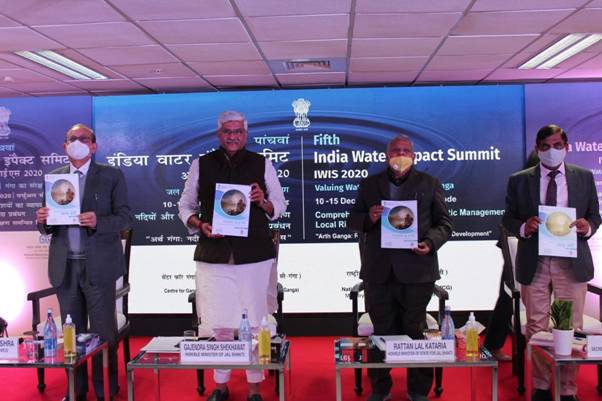A strategic framework developed by NMCG and NIUA to help cities manage the rivers says Hardeep Singh Puri
New Delhi: In the concluding session of the 5th India Water Impact Summit, Shri Gajendra Singh Shekhawat, Minister of Jal Shakti said that the world needs to come together to meet the challenges of the water sector in the same way as the world has united in fighting the COVID-19 Pandemic.The focal point of discussion on the last day of summit today was “River Conservation Synchronised Navigation and Flood Management”.Equating the summit as “VaicharikKumbh” The minister pointed out that the conference resulted in greater interaction between investors and stakeholders in the water sector to promote international cooperation between India and many foreign countries for water and river management. He said, “We have learnt a lot from national and international experiences and it is our promise that we will try to bring these learnings and concepts into practice. There is political will and determination like never before, backed by support from academic and self-help organisations.”
Talking about ground water, Shri Shekhawat said that we use ground water the most in the world. We are working to reduce our dependence on it. We are working on the Atal BhujalYojna, a pioneering initiative to map and recharge aquifers and conserve ground water in collaboration with the World Bank. He said that the scheme has been formed with the main objective of strengthening the institutional structure for groundwater management and bringing about behavioural changes at the community level for sustainable groundwater resource management in 7 states. “The scheme would promote panchayat-centric groundwater management and behavioural change with the main emphasis on demand side management,” he added. Minister of State, Jal Shakti Ministry, Shri Ratan Lal Katariya was also present at the Summit.
Shri. Hardeep Singh Puri, Minister of Housing and Urban Affairs appreciated the momentum and impact created by the NamamiGange mission. He informed that NMCG and National Institute of Urban Affairs (NIUA) have developed a first of its kind strategic framework for managing urban river areas in the Ganga River Basin called the ‘Urban River Management Plan’. “This framework is a river centric planning framework, designed to help cities manage the rivers within their stretches using a systems approach.”, he said.
Shri. Rajiv Kumar, Vice Chairman, NITI Ayog said, “The attitude of pollute now and rejuvenate later must change.” Speaking about the 5th IWIS he said, “This Summit had vast variety and diverse topics of discussion.” He illustrated how conservation and development can go hand in hand and how attempts to involve people in this process is yielding positive results.
Shri Vijay Kumar Choudhry, Minister, Water Resource Department, Bihar apprised the audience about the challenges of Bihar which has rivers entering from Nepal in the north and from other Indian states in the south. He said that flood management is an extremely relevant topic for Bihar because of its geography. He shared that Bihar is actively working on conservation of local water bodies and waste water management. He requested cGanga and NMCG to give a special focus on flood management in Bihar.
Shri U. P. Singh, Secretary, Ministry of Jal Shakti,stated that in the last four years the focus of this Mission has evolved from just cleaning Ganga to rejuvenating her. “Now the Mission is far more holistic which includes not only pollution abatement but also considers e-flow, biodiversity, community participation and small river rejuvenation” he said.
To explore new technologies in water security and rejuvenation of local water bodies in the country, the National Mission for Clean Ganga (NMCG) and the Centre for Ganga River Basin Management and Studies (cGanga) had organised the 5th India Water Impact Summit. Shri Rajiv Ranjan Mishra, Director General, NMCG, Shri RozyAggrawal, Executive Director, NMCG, IIT Kanpur professor and founding head of cGanga, Prof. Vinod Tare also participated in the summit.
More than 3000 intellectuals, researchers, water & environment experts and policy makers joined this Summit from across the world. Three significant reports developed by cGanga were released in the valedictory session of the 5th IWIS, these are Vision Kanh – A sustainablerestoration pathway, Jorari – Revival and Protection and Hilsa -Biology and Fisheries of Hilsa Shad in Ganga River Basin. A detailed report on the 3-day long Ganga Utsav 2020 held recently by NMCG was also released.

